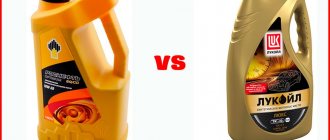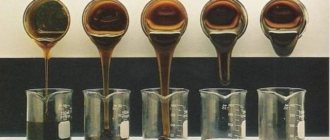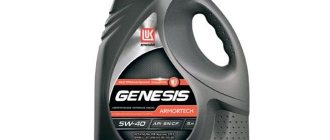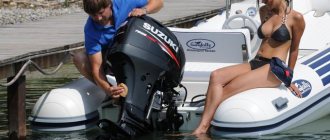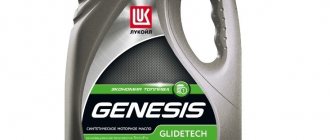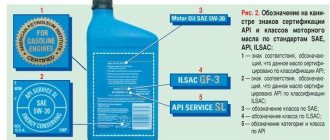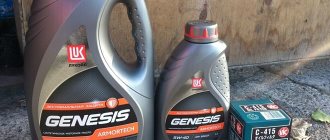Two-stroke engine oil: selection recommendations
Today, a fairly large number of technical means are offered to summer residents and rural residents, which are based on small-sized internal combustion engines. To obtain a higher power value at the output shaft, a two-stroke motor is used. With the same volume, such power units are capable of delivering 70...75% more power than they receive from their four-stroke counterpart.
Another important reason that equipment manufacturers focus on is the real simplification of the internal combustion engine design. The absence of a gas distribution mechanism reduces the cost of the unit by almost half. The only problem with such engines is that you need to prepare a gasoline-oil mixture to fill the fuel tank. Here, the service life of the engine largely depends on the quality of the oil used.
Viscosity, base
2-stroke engines have design features; to ensure their normal operation, it is necessary to select oil that corresponds to the viscosity class specified by the manufacturer of the motorcycle, car and other units. Only the manufacturer can indicate the optimal viscosity for a specific engine type.
If the viscosity is too low, the oil will not protect engine parts from friction - this will lead to wear of the power unit. Using a lubricant that is too thick impairs combustion processes, increases friction losses, and leads to increased carbon formation.
When choosing between mineral and synthetic motor mixtures, follow the rules:
- Mineral water is used in worn-out engines due to the presence of a large amount of carbon deposits in them.
- Synthetics are used in modern drives equipped with an injection or dosage system. Synthetic fluids are characterized by increased properties, so pouring them into power units with high mileage is not recommended.
- Observe the vehicle dealer's approvals and recommendations.
There are BIO oils on the market that have accelerated biodegradation. Their price is 50% higher than conventional lubricants! This cost is due to the ability of combustion products to completely decompose in water; the BIO additive, which is part of these liquids, does not affect the operation of the engine.
We recommend: How to properly fasten a child seat in a car: concern for safety
Synthetic or mineral water
Motor oils are made from different base components. The products are:
- mineral . The base is a product of oil refining. Mineral compositions are inexpensive, but demanding in terms of operating conditions. The viscosity of materials strongly depends on temperature; additive packages contain substances that form carbon deposits;
- synthetic . The base for the oil is synthesized in the laboratory. A package of modern additives is added to the composition to improve performance properties. Synthetic oils have stable viscosity-temperature characteristics, effectively lubricate and protect engine parts, but are more expensive than mineral grades;
- semi-synthetic . Mineral and synthetic bases are mixed in a certain proportion. Semi-synthetics are a balance between affordable price and decent performance.
You can only fill the engine with the product recommended by the manufacturer. Do not mix oils of different brands. To switch from mineral fluid to synthetic fluid, you need to flush the engine.
Pros of motor oil
Oil for a 2-stroke engine must burn completely. Only in this case will the driver be free from soot and ash formations. Do not pour grease from a four-stroke engine into a motorcycle. She won't fit. If you do this, a lot of soot and ash will form in the power unit. If malfunctions appear, the motorcycle will have to be repaired.
Two-stroke oil has the following advantages:
- Lubricates spare parts, thanks to this the engine runs for a long time and smoothly.
- Protects against corrosive effects. Two-stroke engine oil contains additives that resist corrosion. Rust always appears during the operation of the power unit, however, if there is too much of it, the internal combustion engine will break. Oil is the best way to avoid breakage.
- Reduces wear. Lubrication of spare parts not only improves the functioning of the engine, but also reduces friction. This makes it possible to operate the engine for a long time.
- It dissolves well in fuel.
Engine oil performance
What kind of oil to pour into 2-stroke engines? If you use cheap, low-quality oil, a lot of carbon deposits will form in the cylinder block, the piston rings will become coked, and engine parts will wear out. In view of this, a suitable petroleum product with good characteristics must be poured into the internal combustion engine of a motorcycle.
Types of lubricants
Currently, all oil liquids are divided into 3 categories (differing in the origin of the petroleum product):
- Mineral oil. Doesn't have the best characteristics. Used in old cars.
- Synthetic oils. They are made in laboratories, have excellent performance indicators, but are quite expensive.
- Semi-synthetic oils. Semi-synthetics are made by mixing mineral water and synthetics. It has good characteristics and is inexpensive. The best option for Russian car enthusiasts.
SAE classification is common today. Accordingly, all lubricants are divided into categories based on viscosity. The brand of consumables does not matter. This classification is simple. Even an inexperienced car owner can understand what kind of oil to pour into 2-stroke engines. The markings on the canister contain information about the low- and high-temperature viscosity of the consumable. In addition to SAE, API and ACEA classifications are used in the Russian Federation.
The best oils for four-stroke outboard engines
5 Mannol 7820 Aqua Jet 4-Takt 1l
Mannol 7820 Aqua Jet 4-Takt 1l
Mannol 7820 Aqua engine oil was specially developed for high-power four-stroke motor boats and jet skis equipped with turbochargers. The stable additive formula best promotes the stable operation of the lubrication system of jet engines and prevents the formation of small particles that can damage the mechanism.
The excellent anti-corrosion properties of the oil prevent the formation of rusty deposits, which inevitably appear upon contact with water. The components contained in motor oil reduce friction in moving parts, ensuring their smooth operation for a long time. Due to the low-ash composition of the oil, soot and varnish deposits do not form on the engine, which makes it possible to use water-powered equipment equipped with catalytic converters. Even if water accidentally enters the housing, the oil is able to operate effectively at full speed without breaking the lubricant film. The product specification and approval have the following compliance: SAE 10W-40, API SL, JASO MA.
4 Wolf Outboard 4T 10W30 1l
Wolf Outboard 4T 10W30 1l
High-quality semi-synthetic oil is created on the basis of carefully selected base oils of the highest purity and is intended for modern four-stroke engines, the most famous of which are Mercury Marine and Yamaha. The oil is formulated to meet NMMA FC-W requirements and is capable of providing enhanced protection against rust that quickly forms when exposed to salt water. Having compounds of molybdenum and zinc molecules in its structure, the oil comprehensively protects against aggressive environments and keeps the engine exceptionally clean.
Special additives give the oil better oxidation resistance, help it penetrate the entire system faster and maintain the stability and reliability of the lubricating film without clogging the oil filter. The composition of the oil guarantees a reduction in fuel consumption and reduces the amount of smoky emissions. The oil has very low volatility, which allows it to be used at any time of the year.
3 Motul Suzuki Marine 4T SAE 10W40
Motul Suzuki Marine 4T SAE 10W40
Semi-synthetic oil created specifically for a series of Suzuki outboard engines. It is distinguished by being tailored to the operating conditions of these particular developments, so the limits of applicability and adequacy of use with other models of power units should be felt, as they say, from personal experience. Fortunately, no one forbids doing this.
As users note, purely technically, Motul Suzuki Marine 4T SAE 10W40 is no different from the standard series of oils from the same company. Any composition with a viscosity of 10W40 shows approximately the same results, but is much cheaper than a premium development for branded engines. Of course, no one cancels the outstanding parameters for combustion, environmental friendliness and efficiency, but behind all this one can feel a carefully planned commercial move, which led to some coldness among domestic consumers. A well-deserved third place.
2 Quicksilver 4-Stroke Marine 10W-30
Quicksilver 4-Stroke Marine 10W-30
Quicksilver 4-Stroke Marine 10W-30 is an interesting semi-synthetic that became widespread first in America, and then moved equally effectively to the domestic market. The uniqueness of this oil lies in its specific requirements for use. While in automobile engines the lubrication of the rubbing parts occurs under the influence of high pressure, in boat engines the oil is delivered only through splashing (which is facilitated by the presence of an immersion ring on the shaft). Under such conditions, for unhindered lubrication, the technical fluid must be sufficiently low-viscosity to ensure expansion even at low speeds. And Quicksilver 4-Stroke Marine 10W-30 copes with this task, perhaps better than others.
This oil is relatively inexpensive, which accounts for its high popularity. However, there is a different kind of problem here: since the company is small and production is limited, it is very difficult to find its products outside of dealer centers and official distributors.
1 Motul Outboard Tech 4T 10W30
Motul Outboard Tech 4T 10W30
The undisputed leader of the rating is another representative of the Motul company, which has recorded not only outstanding technical and operational indicators, but also price indicators. It is at least stupid to challenge its leadership: one fill of oil is enough for a long time, there is no intense soot during combustion, and the cost of four-stroke semi-synthetics is not much higher than that of two-stroke engines.
Another feature of Outboard Tech 4T 10W30 that users love so much is the complete safety of mixing different types of oils. This composition can be mixed with mineral or purely synthetic oil in any proportion, and this will in no way affect the functioning of the engine.
In general, Outboard Tech 4T 10W30 can be considered the flagship not only of a single series, but also of the entire motor oil market in the special equipment segment, since all the prerequisites for this are evident.
Engine oil requirements for a two-stroke engine
The technological solution for providing lubrication in an internal combustion engine of a two-stroke cycle is carried out in two ways.
- Mixing gasoline and lubricant when filling the fuel tank.
- Separate supply of fuel and lubricant components. The issue is resolved in two-stroke diesel engines in a similar way. There are two tanks: the main one is filled with fuel; in the auxiliary - oil.
We recommend: 20 most economical cars
Industry use of two-stroke diesel engines is quite limited. Most often these are marine engines with a long piston stroke. For users, the first method is more common. It is used
- on mobile equipment: motorcycles, scooters, motorbikes, walk-behind tractors, motor-cultivators and other devices;
- for small-scale mechanization in everyday life: chainsaws, brush cutters, drilling rigs and a number of other devices.
Main characteristics of motor oil
- Viscosity is the ability to form a stable film on the contact surface of mechanical elements. For heat engines, it is necessary to ensure the stability of this indicator over a wide temperature range (-20...+60 ⁰С).
- Turnover is the second important indicator. The lubricating fluid must fill the space provided to it. When starting the engine, its temperature is still quite low, so it is necessary for oil to penetrate the crank mechanism and settle on the cylinder walls.
- Presence of anti-stick additives . This requirement arose relatively recently. Components began to be added approximately 20...25 years ago. As a result, breakdowns are less likely to occur due to rings being stuck in the piston grooves. At temperatures above 2000...2100⁰С, which is observed during fuel combustion, additives do not allow the oil to form crystals that settle at different points where it is difficult to wash them out.
- Antifoam additives prevent the formation of gas bubbles on the surface of the oil film. Where a gas bubble is present, the film thickness is minimal. “Dry” contact between mating parts is possible.
- Anti-corrosion properties. The lubricant should not be oxidized by oxygen contained in the air. Therefore, the composition necessarily contains a small amount of saturated hydrocarbons (paraffins). They form a protective coating on the surface that prevents oxygen from reaching the metal.
- Solubility in gasoline is an indicator without which a lubricant cannot be used. In practice, it is necessary to create fuel-lubricant mixtures with different ratios. For heavy motorcycles, it is necessary to prepare a heavy proportion, in which 15...25 parts of fuel are poured into 1 part of oil. For light trimmer motors, a light mixture is needed; a proportion of 1: 40...50 is maintained.
- The stability of properties is characterized by the preservation of initial indicators over a long period. The liquid should not separate. Precipitation of inclusions is not allowed.
We recommend: Bleeding a car's clutch in a garage
At the heart of a motor lubricant there is a load-bearing part, as well as additive components that determine the main characteristics of the material.
Range of ROLF 2T motor oils for two-stroke engines
ROLF GARDEN 2T . Low ash semi-synthetic motor oil with the highest performance class JASO FD. The product is designed to protect highly loaded engines operating at high speeds and under severe conditions. ROLF GARDEN 2T oil meets the requirements of international environmental standards in terms of the level of toxic substances in exhaust gases and the degree of smokiness. It is used in various types of garden equipment, in generators, and in tools. Advantages of ROLF GARDEN 2T engine oil:
- excellent cleaning properties, effective cleaning of engine parts, protection against coking of piston rings, increased service life of spark plugs;
- high-quality lubrication and cooling of metal surfaces, preventing wear;
- reliable protection against corrosion due to the oxidative stability of the product;
- maintaining viscosity at extremely low temperatures, facilitating cold starts.
ROLF MOTO 2T. Low ash semi-synthetic oil of JASO FD class. Designed to protect engines of equipment operating in high-speed modes and in difficult operating conditions. ROLF MOTO 2T oil is designed specifically for two-stroke engines of scooters, scooters, snowmobiles, ATVs, and motorcycles. Product advantages:
- high cleaning power, protection against coking of piston rings;
- efficient engine cooling at high speeds;
- formation of a stable lubricating film, protection against wear and overheating;
- anti-corrosion properties;
- stable viscosity at low temperatures;
- compliance with environmental standards for smoke and toxicity of exhaust gases.
Source
Principle of operation
A 2-stroke engine does not have a crankcase; it is lubricated by a mixture of oil and fuel, which completely burns in the combustion chamber of the engine cylinder. Motor fluids for four-stroke units do not come into contact with fuel. Due to differences in operating principles, lubricant manufacturers have different requirements for the properties of motor fluids for 2-stroke and 4-stroke drives.
A 2-stroke engine requires oil that will burn completely in the combustion chamber without leaving sediment or soot. It is important that unburned oil residues entering the exhaust gases are biodegradable.
For four-stroke power units, the main parameter of motor mixtures is viscosity - the ability of liquids to maintain their structure under various operating conditions to ensure the formation of a durable lubricating film on the drive elements.
Design and principle of operation
A two-cycle drive is installed in places where small dimensions and low weight are important. The design of the unit includes: a crankcase with channels, a cylinder block, a crankshaft, pistons. The unit operates in two strokes: compression and stroke.
When compression occurs, the piston begins to move from its lowest to its highest position (top and bottom dead centers). As it moves, it blocks the purge and exhaust holes, forming a sealed chamber. At the moment the holes close and the piston moves upward, gasoline is supplied to the cylinder. The gasoline-air mixture is compressed to its maximum when the piston reaches its highest point. A discharged space is formed under the piston, in the crank chamber. It facilitates the flow of fuel from the carburetor through the inlet channel.
Maintenance of a two-stroke engine
Like any unit, the engine must be technically maintained. Two-stroke motor oil, intended for engine lubrication, has specific application features. They must be taken into account for the proper functioning of the vehicle and to prevent problems.
The operating rules for a two-stroke power unit are as follows:
- Clean the oil tank and the pipeline through which the lubricant flows annually;
- excess spilled petroleum product must be eliminated;
- Use an oil filter to clean engine oil from engine wear products.
By following the listed operating rules, you will be able to operate a two-stroke engine for a long time. Replace consumables correctly. If you are not confident in your abilities, it is better to contact a service center. Its employees, in addition to carrying out maintenance, will explain to you what kind of oil to pour into 2-stroke engines, and will help you understand the classifications of petroleum products used. The difference between this approach and carrying out maintenance yourself is that you will need to pay the car service workers a sum of money.
